Serving 424 students in grades Kindergarten-8, Princeton Charter School ranks in the top 1% of all schools in New Jersey for overall test scores (math proficiency is top 5%, and reading proficiency is top 5%).
The percentage of students achieving proficiency in math is 86% (which is higher than the New Jersey state average of 36%). The percentage of students achieving proficiency in reading/language arts is 92% (which is higher than the New Jersey state average of 49%).
The student:teacher ratio of 11:1 is equal to the New Jersey state level of 11:1.
Minority enrollment is 71% of the student body (majority Asian), which is higher than the New Jersey state average of 62% (majority Hispanic and Black).
Quick Stats (2025)
- School Type: Charter School
- Grades: Kindergarten-8
- Enrollment: 424 students
- Student:Teacher Ratio: 11:1
- Minority Enrollment: 71%
- Overall Testing Rank: Top 1% in NJ
- Math Proficiency: 86% (Top 5%)
- Reading Proficiency: 92% (Top 1%)
- Science Proficiency: 75-79% (Top 1%)
- Source: National Center for Education Statistics (NCES), NJ Dept. of Education
Top Rankings
Princeton Charter School ranks among the top 20% of public schools in New Jersey for:
Category
Attribute
Overall Rank
Math Proficiency
Reading/Language Arts Proficiency
Science Proficiency
Student Attention
School Overview
Princeton Charter School's student population of 424 students has stayed relatively flat over five school years.
The teacher population of 38 teachers has stayed relatively flat over five school years.
School Type
Grades Offered
Grades Kindergarten-8
Total Students
424 students
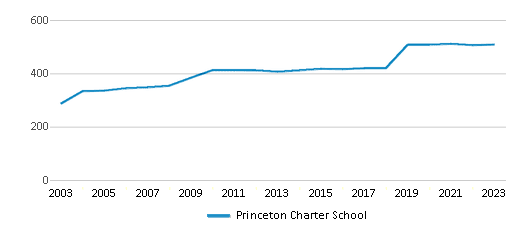
Gender %
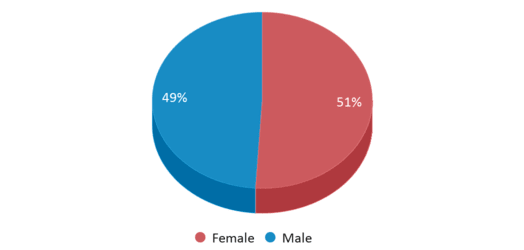
Total Classroom Teachers
38 teachers
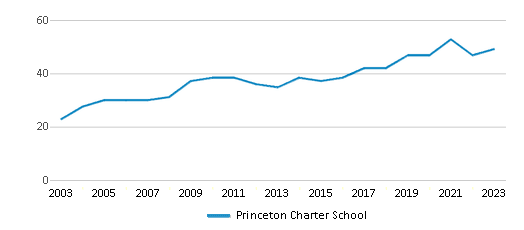
Students by Grade

School Rankings
Princeton Charter School ranks within the top 1% of all 2,201 schools in New Jersey (based off of combined math and reading proficiency testing data).
The diversity score of Princeton Charter School is 0.63, which is less than the diversity score at state average of 0.72. The school's diversity has stayed relatively flat over five school years.
Overall Testing Rank
#20 out of 2201 schools
(Top 1%)
(Top 1%)
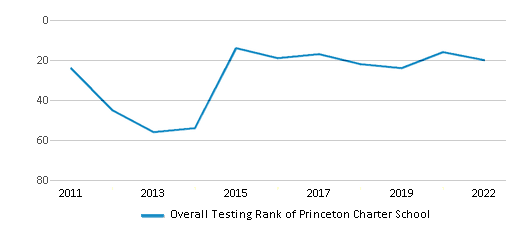
Math Test Scores (% Proficient)
86%
36%
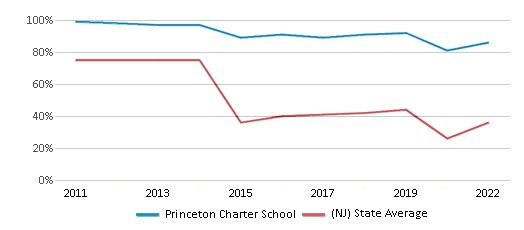
Reading/Language Arts Test Scores (% Proficient)
92%
49%
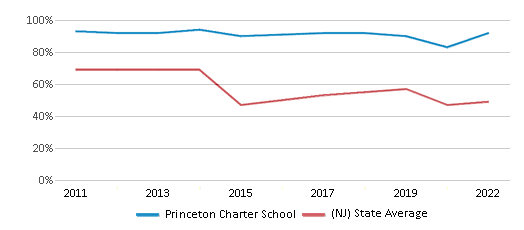
Science Test Scores (% Proficient)
75-79%
23%
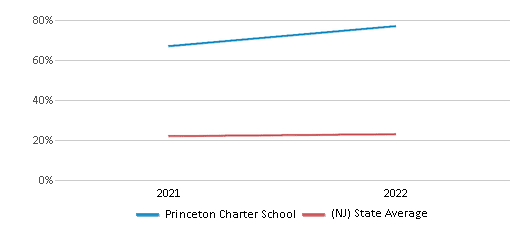
Student : Teacher Ratio
11:1
11:1
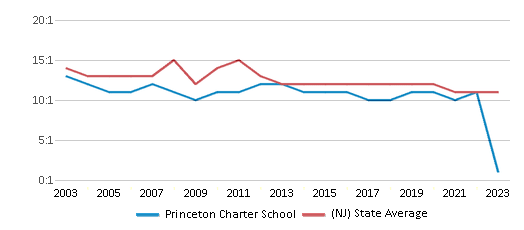
American Indian
n/a
n/a
Asian
53%
10%
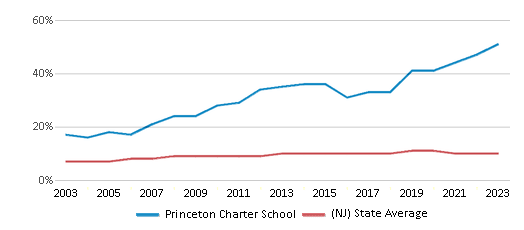
Hispanic
5%
34%
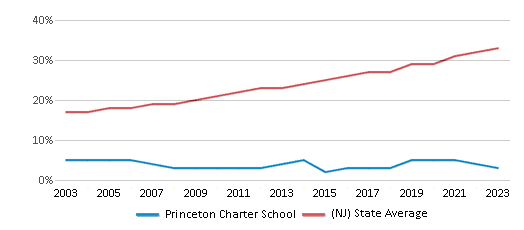
Black
3%
15%
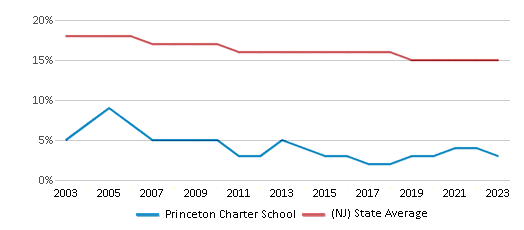
White
29%
38%

Hawaiian
n/a
n/a
Two or more races
10%
3%

All Ethnic Groups
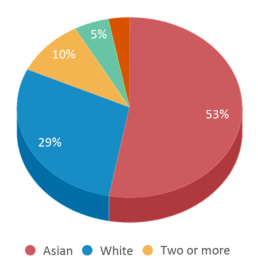
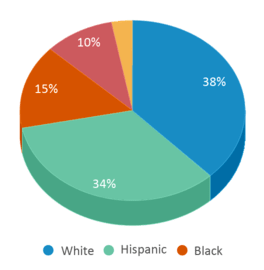
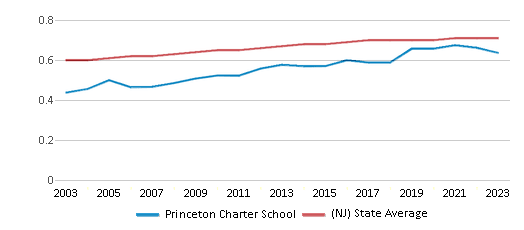
Participates in the National School Lunch Program (NSLP)
Yes
Eligible for Free Lunch
3%
32%

Eligible for Reduced Lunch
1%
6%
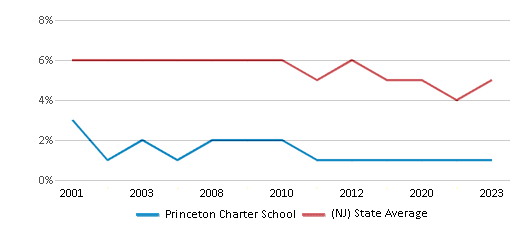
School Statewide Testing
School District Name
Source: National Center for Education Statistics (NCES), NJ Dept. of Education
Profile last updated: 02/09/2025
Frequently Asked Questions
What is Princeton Charter School's ranking?
Princeton Charter School is ranked #20 out of 2,201 schools, which ranks it among the top 1% of public schools in New Jersey.
What schools are Princeton Charter School often compared to?
Princeton Charter Schoolis often viewed alongside schools like Littlebrook School by visitors of our site.
What percent of students have achieved state testing proficiency in math and reading?
86% of students have achieved math proficiency (compared to the 36% NJ state average), while 92% of students have achieved reading proficiency (compared to the 49% NJ state average).
How many students attend Princeton Charter School?
424 students attend Princeton Charter School.
What is the racial composition of the student body?
53% of Princeton Charter School students are Asian, 29% of students are White, 10% of students are Two or more races, 5% of students are Hispanic, and 3% of students are Black.
What is the student:teacher ratio of Princeton Charter School?
Princeton Charter School has a student ration of 11:1, which is equal to the New Jersey state average of 11:1.
What grades does Princeton Charter School offer ?
Princeton Charter School offers enrollment in grades Kindergarten-8
What school district is Princeton Charter School part of?
Princeton Charter School is part of Princeton Charter School District.
School Reviews
1 2/3/2022
The school prioritizes academic performance over social skill development. The administration bypasses standard protocols to ensure students have a safe environment free of bullying and negative peer behavior. Emphasis on scores, both standard and reported, drives day-to-day focus. A loophole in the admissions lottery enables families to apply from international locations which has influenced the enrollment and community dynamic of the school.
5 2/21/2019
I am a new parent at PCS with two children enrolled. This school has been a wonderful environment for my children to thrive in. The teachers are all so wonderful and caring. Yes, it is an academically challenging school, providing fantastic opportunities to students who are ready to take the next step. The school is very supportive to all students. We love the close knit community this school offers. The smaller class size provides more individualized instruction that has been very beneficial. A truly wonderful school!
2 9/1/2015
Now looking back after graduating high school, I feel this school had a negative impact, if any impact whatsoever to my overall education. The teachers were either nice people with terrible teaching skills or plain terrible all around. Throughout my three years at the school, I was bullied to the point that I did not want to come to school in fear of what I would face.Even after telling the guidance counselor and principal multiple times, nothing was ever done. School used to be enjoyable for me, but PCS changed that. Hopefully, I never have to set foot on those grounds again.
Review Princeton Charter School. Reviews should be a few sentences in length. Please include any comments on:
- Quality of academic programs, teachers, and facilities
- Availability of music, art, sports and other extracurricular activities
Recent Articles

What Is A Charter School?
Explore the world of charter schools in this comprehensive guide. Learn about their history, how they operate, and the pros and cons of this educational innovation. Discover key facts about charter schools, including admission policies, demographics, and funding, as well as what to look for when considering a charter school for your child.

10 Reasons Why High School Sports Benefit Students
Discover the 10 compelling reasons why high school sports are beneficial for students. This comprehensive article explores how athletics enhance academic performance, foster personal growth, and develop crucial life skills. From improved fitness and time management to leadership development and community representation, learn why participating in high school sports can be a game-changer for students' overall success and well-being.

February 05, 2025
Understanding the U.S. Department of Education: Structure, Impact, and EvolutionWe explore how the Department of Education shapes American education, from its cabinet-level leadership to its impact on millions of students, written for general audiences seeking clarity on this vital institution.









